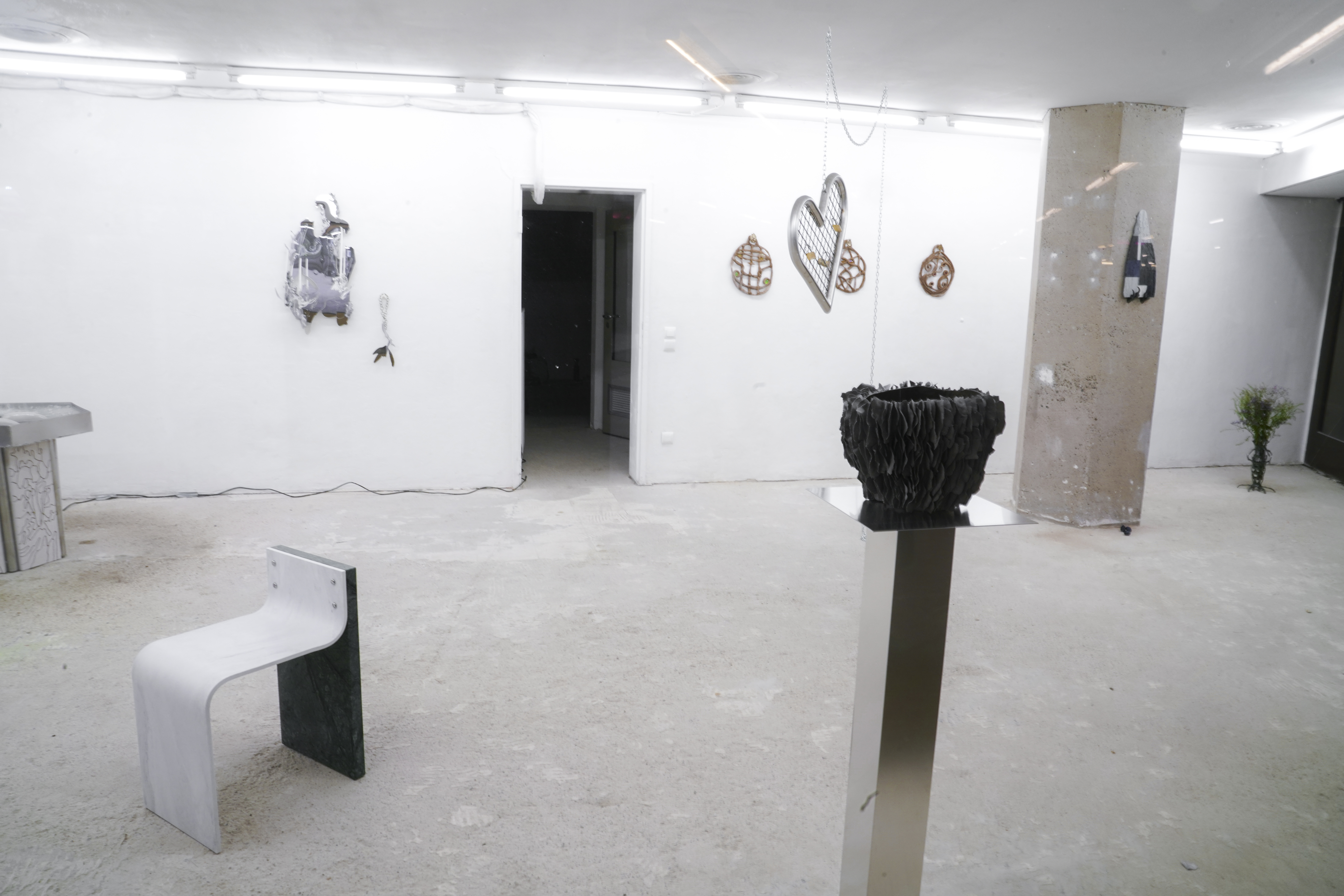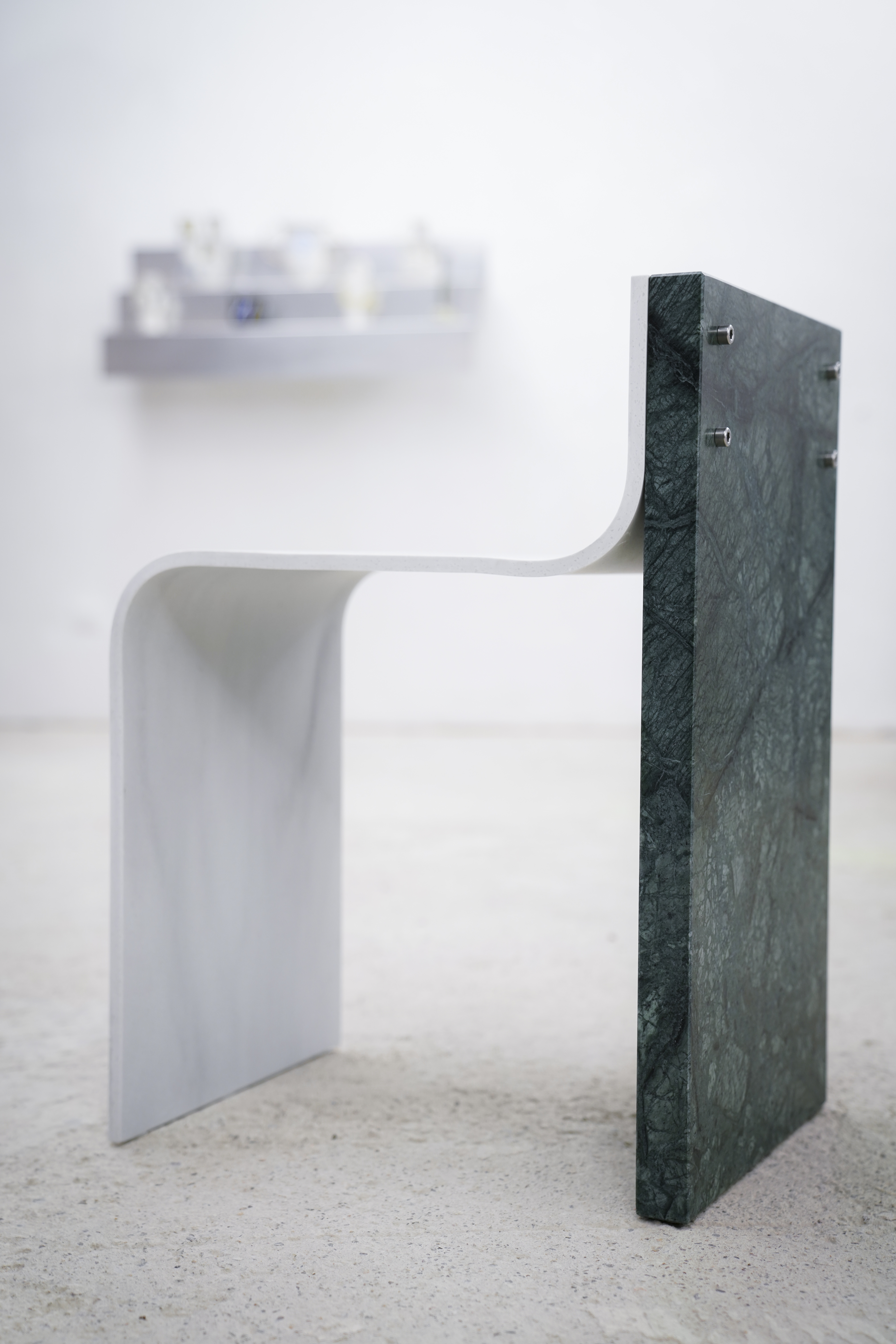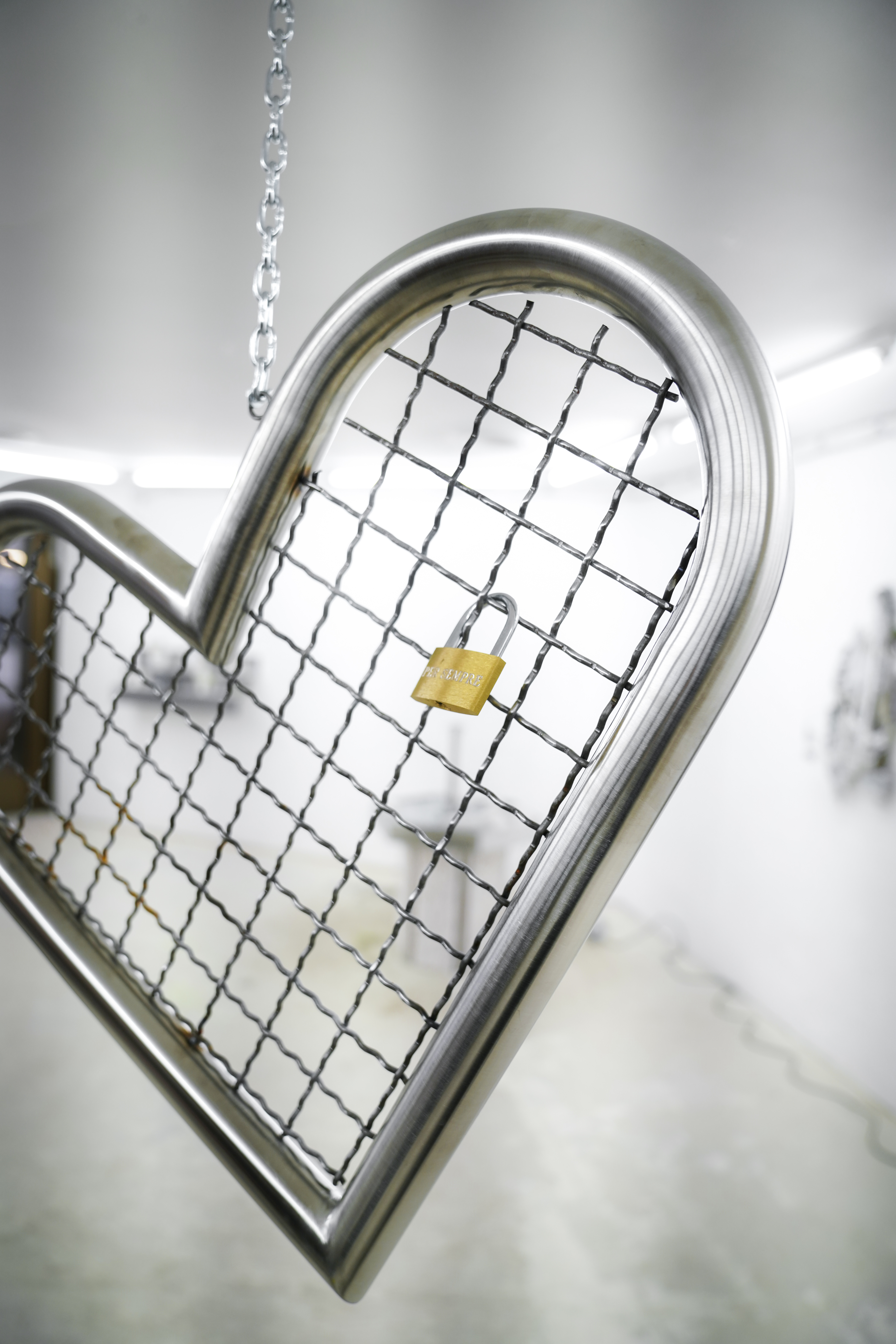


MULTILOGUE digital
In the spring of 2020, at the suggestion of the Cologne-based project space 101PS, a collaboration of 10 female artists and designers began. Numerous digital meetings were followed by a 10-day stay together in an old monastery
ruin at the foot of the Calmont on the Moselle. Each participant prepared thematically for the expedition and not only presented their own research results, but also led a disciplinary workshop for the group. Together, they researched new approaches to interdisciplinary exchange and a symbiotic design process.
For seven days, the designers from France, the Netherlands and Germany will present the results of their workshops on the theme of everyday life and mysticism in the project spaces GOLD+BETON and Mouches Volantes. They were inspired by historical Cologne women’s figures, such as Agrippina or St. Ursula, by Cologne landmarks, such as Matané’s dove fountain, and by everyday objects specific to Cologne, such as the ancient Roman snake-thread glass objects with Cologne curlicues and Baroque mirrors. The designers invite a contemporary dialogue between then and now, between analog and digital.
„Multilogue“ are Lisa Ertel, Jenna Kaes, Hannah Kuhlmann, Delphine Lejeune, Juliana Maurer, Anne-Sophie Oberkrome, Clara Schweers, Kurina Sohn, and Tatjana Stürmer – 9 designers who have formed a temporary working group as part of the project space 101PS.
In order to escape the digital, and enter the physical world – they form a dialogue between residents and environment, between everyday life and mysticism, between then and now. After their 10-day workshop at the foot of Calmont, they now present their new works in a double show at GOLD+BETON and Mouches Volantes.
Multilogue digital
How are digital exchanges between artist evolving? How do individual interests correspond withdifferentdisciplines? How do these disciples melt into each other? Mouches Volantes presents works formed within small digital groups.
Multilogue analog
During one week GOLD+BETON is transformed into a physical workspace. A daily observatory welcoming physical exchange between the designers and visitors. A room for exchange exploring the GENIUS LOCI of Ebertplatz embedded in stories of Cologne.
How are digital exchanges between artist evolving? How do individual interests correspond withdifferentdisciplines? How do these disciples melt into each other? Mouches Volantes presents works formed within small digital groups.
Multilogue analog
During one week GOLD+BETON is transformed into a physical workspace. A daily observatory welcoming physical exchange between the designers and visitors. A room for exchange exploring the GENIUS LOCI of Ebertplatz embedded in stories of Cologne.
17.–23.01.2022
EXHIBITION:
17.–23.01.2022
ADRESS:
︎︎︎Mouches Volantes
Ebertplatzpassage Laden 1
50668 Köln
︎︎︎GOLD+BETON
Ebertplatzpassage Laden 3
50668 Köln
open daily from
3pm–8pm
OPENING:
17.01.2022
6pm
MORE INFORMATION
VIA INSTAGRAM:
︎︎︎@101ps.space
︎︎︎@lisa_errtel
︎︎︎@jennakaes
︎︎︎@studiokuhlmann
︎︎︎@demc__
︎︎︎@julijanamaurer
︎︎︎@annesophie_oberkrome
︎︎︎@claerira
︎︎︎@sohnkuri
︎︎︎@_tatjanasturm
HANDOUT: MULTILOGUE digital at Mouches Volantes
HANDOUT: MULTILOGUE analog at GOLD+BETON






Snow Piecer
Kurina Sohn, Clara Schweers & Delphine Lejeune
A mirror pierced by snowdrops/ perce-neige/ Schneeglöckchen/설강화:
The specimen {gála–ánthos} cracks ice to
bear spring. Its milky flower blossoms in correspondence with snow-pierced landscapes.
A messenger for the end of hibernation mode, an indicator towards the change of seasons; through which we sense the rise of a new year.
In our mother tongues the name of the plant {snowdrop/ perce-neige/ Schneeglöckchen/ 설강화} alludes to different meanings, characteristics, and associations a spectator may have when spotting a group blooming under a tree. The Snow–Pierced Mirror is inspired by those different associations, each of us attaches to the species. Visually referencing bells, as their heads hang from the stem, or the way the plant grows, breaking layers of snow, and what ability it is connected to living in and flourishing through harsh temperatures. Strength/ force/ Stärke/ 힘.


Pina
Anne–Sophie Oberkrome & Lisa Ertel
The marble statue as well as the curvy Klismos chair was reserved for gods and the emperors of the Roman Empire. Cologne‘s founder Agrippina was also immortalized in stone, sitting on a Klismos throne. The dubious and contradictory reputation
of Agrippina raises questions about male historiography and who or what is responsible for transmission of knowledge and history. What is real, the truth, what is mirage or propaganda? Was Agrippina a bloodthirsty ruler or did she simply interfere too much in politics for a woman and was therefore denounced by her own son and the male historians? The petrified throne visualizes those questions.


Ursula’s Diptych
Jenna Kaes & Studio Kuhlmann
A diptych-reliquary crystallizing scenes from the legend of Saint Ursula and the eleven Virgins, Martyrs of the city of Cologne. Its trembling hand manufacturing, and shelter shape refer to Santa Ursula’s Goldene Kammer. A room fulfilled with shrines, altars and bones ornaments. Situated in Santa Ursula church on Ursulaplatz, and built upon an old Roman cemetery. A world in itself, built to remind us the value of life.
An edition of 12 pendants ( +2 AP) was produced for this exhibition. Each of the pendants is
a unique representation of one of the eleven Jungfrauen.
 Serpent Squiggles
Serpent SquigglesLisa Ertel, Juliana Maurer & Anne–Sophie Oberkrome
Hidden and embraced by the heat of the kiln, the glass threads start their dance. Attracted by gravity, they wind and snake around the vessels until they sink to the surface of the pottery where they slowly solidify. Ancient glass was discovered in the late 3rd century BC as an accidental byproduct of ceramic production. Furthermore, the early history of ancient glass over a long period of time is a juxtaposition of ceramic pottery and the forgotten technique of glass pottery. The technique of serpentine glass apllication comes from the East and was later perfected in Cologne. The Cologne snake thread glass with its trademark, the „Kölner Schnörkel“ (Cologne scroll), became an export hit throughout the entire Roman Empire.


Digit V–A
Clara Schweers
Last summer I visited the Romano-Germanic Museum. I was especially astonished by the Cage Cup {Diatretglas}. A glass-object found buried alongside a body of a roman cemetery in Cologne. A burial good, inscribed with the message Drink, live well, forever. {Trinke, lebe schön, immerdar.} It became a central point of inspiration for the presented object Digit V-a. Not only as a visual reference, but questioning its manufacturing process and context as well. How did the diatrearii {the carvers} manufacture the Cage Cup in the first place? How did they construct
the drinking vessel, revealing the net structure as particular character to the object? A seemingly digitally manipulated object, setting a precedent for itself. Did its physical presence informing digital techniques today? Digit V-a is a physical manipulation, constructed through an assemblage of digiti {fingers}. They compose a fifth-digit-
net, posited as consuming mouths, expelling and reaching upwards, attracting and ensnaring prey.


Pigeon Fountain
Delphine Lejeune, Studio Kuhlmann
Why do people disrespect pigeons?
Just because they make a mess
Just because they huddle round your feet When you’re walking down the street
Just because they don’t sing a pretty song
It doesn’t mean that they are wrong
Look again
Their pretty necks have turquoise purple shiny green scarves
Purr like a cat they do
Fat necked king pigeon
I like you
By Niko Matthews
With help from Ava Bodroghy-West and Amelia Keeffe
 Pigeon
PigeonDelphine Lejeune
In past history and through different cultures, pigeons have been associated to goddesses related to Love, Sexuality and War. As faithful companions, they would be strongly respected species and often used as offerings.
“Queen of Heaven” is a reflection of our current relationship with this bird specie and an invitation to question the mutation process that it suffered; falling from goddess symbol to urban parasite.



Stained Glass Bretzels
Jenna Kaes
In 1477, the King’s appointed baker was sentenced to imprisonment for missing his
bread. In despair, his wife went to beg the monarch to give her husband one last chance, which turned into a challenge: to redeem himself, the baker had to invent a bread that the sun could cross three times. The baker then set to work, but no inspiration came. Then, looking out of his kitchen window, he saw his wife praying for him on her knees. As a tribute, he made a bread in the shape of her praying arms. As he showed it to her, the sun shone through the three holes in the bread and the baker knew that he was saved.
This series of Baroques fences bretzels generate a play of shadow and colored lights. A series of stained glass breads, to use as wall amulets.of shadow and colored lights. A series of stained glass breads, to use as wall amulets.
Jenna Kaes
In 1477, the King’s appointed baker was sentenced to imprisonment for missing his
bread. In despair, his wife went to beg the monarch to give her husband one last chance, which turned into a challenge: to redeem himself, the baker had to invent a bread that the sun could cross three times. The baker then set to work, but no inspiration came. Then, looking out of his kitchen window, he saw his wife praying for him on her knees. As a tribute, he made a bread in the shape of her praying arms. As he showed it to her, the sun shone through the three holes in the bread and the baker knew that he was saved.
This series of Baroques fences bretzels generate a play of shadow and colored lights. A series of stained glass breads, to use as wall amulets.of shadow and colored lights. A series of stained glass breads, to use as wall amulets.



“Liebe deine Stadt”
Studio Kuhlmann
Uniquely, Cologne’s Hohenzollern Bridge is
a place of pilgrimage for romantics in love. Cologne residents as well as tourists from all over the world like to immortalize their never- ending special relationship in the form of love locks on the bridge. As a sign of eternal love and fidelity, they attach their lock to the bridge grate and throw the corresponding key into the Rhine. «Liebe deine Stadt” is a participatory object to which locks can be attached during the exhibition week, just like the Hohenzollern Bridge.


A walk in the forrest
Juliana Maurer
The sculpture crystalizes the research done during the first Genius Loci workshop in Bremm, last summer. It is inspired by the natural environment there which is full of slate pieces. The Sculpture plays with contradictions which reflect the contrast between nature and the
city. The organic shape, made of the oldest raw material (clay), is placed on a shiny, cold, metal pedestal surrounded by the urban environment of the city.

jumping back and forth between parallel planes –
encounter a soft digitalism,
recalling a rough analog travelling
bodies stuck between two worlds
mired within a twilight zone
amid roots enclosed by portal veils and veins
through the eco-social meshwork
– shifting materiality
stretching out our antennas, our tentacles, our hands
– immersed
oscillations, imaginations, transformations
carved from material knowledge
– forming a parallel present
this is our zone
101PS
info@101ps.space
+49 174 694 343 1
Hartwichstraße 101
50733 Cologne
Germany
info@101ps.space
+49 174 694 343 1
Hartwichstraße 101
50733 Cologne
Germany
© 2020 101PS
